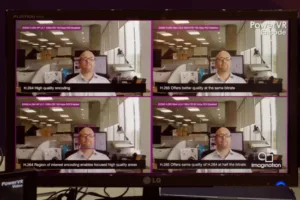We spoke to Imagination Technologies at CES, but the company still managed to have plenty of news at MWC. The first news was support by Imagination of the Vulkan low level API that has been developed by open source organisation, Khronos. (Although more sophisticated APIs such as OpenGL can make programming easier, those that want to get the maximum performance out of hardware tend to want to go “direct to the metal”. As GPUs have got closer in architecture, it has made sense to develop a low level API that game and other application developers can use to get the best possible architecture. That needs more effort from the developer than using a high level API such as OpenGL, which will continue to be developed – Man. Ed.) Supporters of the Vulkan API include Valve which will support it in the SteamOS and future Valve games. The Vulkan API should work on any platform that supports OpenGL ES3.1 or above and Imagination said that in some cases, the code size is just 20% of equivalent OpenGL code.
Imagination told us that it has seen an industry shift that, these days, is much more accepting of the logic of the kind of tiling architecture that it has always used.
Imagination also sells video cores these days and there was an interesting demonstration of the advantages of its latest H.265 encoder technology. There was a demonstration display of four windows of videoconferencing material with H.264 and H.265 at low and high bit rates. Imagination’s codec is capable of detecting and identifying a “region of interest”, such as a face in a videoconferencing application. Resources can then be optimised for that part of the screen rather than backgrounds. It was clear that even in this kind of application, H.265 is a good solution, delivering much better looking video than the H.264 streams even down to very low bit rates such as 80 kbps.
Imagination’s H265 technology produces very good video quality even at just 80kbps
We then looked at a very small and low power Wi-fi (802.11ac) receiver that can be combined with a GPU and video decoder that are low enough power and small enough to be integrated into a “Chromecast”- type dongle.
Finally, we had a look at Imagination’s MIPS technology being used by Blu Wireless Technology of the UK to develop a 60GHz module that can be used for wireless backhaul. The company said that its adaptors are “radio agnostic” so were using SiBeam technology, but could also use 802.11ad. As well as backhaul applications, the technology can be exploited in mesh network applications where the configurable beam steering can mean useful levels of “densification”.

